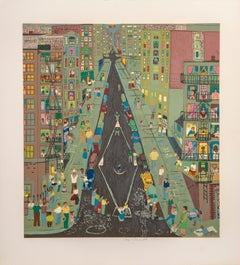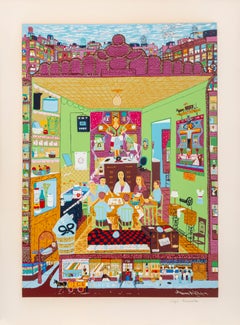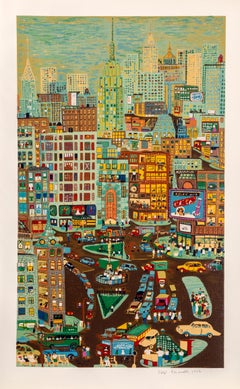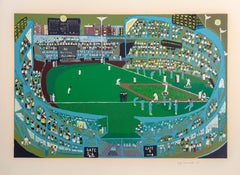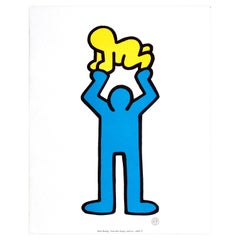Ralph Fasanella Art
to
11
11
9
8
2
1
1
1
Ralph Fasanella "May Day" Signed Screenprint
By Ralph Fasanella
Located in Skokie, IL
Ralph Fasanella "May Day" Signed Screenprint
"May Day" signed screenprint by New York folk artist Ralph Fasanella (1914-1997). Fasanella was a self-taught outsider artist and renown...
Category
1970s American Folk Art Vintage Ralph Fasanella Art
Materials
Plexiglass, Wood, Paint
Bridges, New York - Screenprint by Ralph Fasanella
By Ralph Fasanella
Located in Long Island City, NY
Artist: Ralph Fasanella, American (1914 - 1997)
Title: Bridges
Year: 1974
Medium: Screenprint on Arches Paper, signed and numbered in pencil
Edition: 250, AP 25
Image: 25 x 34 inches...
Category
1970s Folk Art Ralph Fasanella Art
Materials
Screen
Stickball, New York Screenprint by Ralph Fasanella
By Ralph Fasanella
Located in Long Island City, NY
Rendered in hues of blue, teal, and brown, this Ralph Fasanella print is a bustling depiction of New York City including views of identifiable landmarks from various boroughs and loc...
Category
1970s Folk Art Ralph Fasanella Art
Materials
Screen
Family Supper, Serigraph by Ralph Fasanella
By Ralph Fasanella
Located in Long Island City, NY
Artist: Ralph Fasanella, American (1914 - 1997)
Title: Family Supper
Year: 1974
Medium: Screenprint on Arches Paper, signed in pencil
Edition: 250, AP 25
Size: 41 in. x 31 in. (104.1...
Category
1970s Folk Art Ralph Fasanella Art
Materials
Screen
Empire State Building, Screenprint by Ralph Fasanella
By Ralph Fasanella
Located in Long Island City, NY
Artist: Ralph Fasanella, American (1914 - 1997)
Title: Empire State
Year: 1974
Medium: Screenprint on Arches Paper, signed and numbered in pencil
Edition: 300
Image: 40 x 24 inches
S...
Category
1970s Folk Art Ralph Fasanella Art
Materials
Screen
Ballpark, Silkscreen by Ralph Fasanella
By Ralph Fasanella
Located in Long Island City, NY
Artist: Ralph Fasanella, American (1914 - 1997)
Title: Ball Park
Year: 1974
Medium: Screenprint on Arches Paper, signed and numbered in pencil
Edition: 250
Image: 25 x 37 inches
Size...
Category
1970s Folk Art Ralph Fasanella Art
Materials
Screen
Going to Work, New York Screenprint by Ralph Fasanella
By Ralph Fasanella
Located in Long Island City, NY
Rendered in hues of blue, teal, and brown, this Ralph Fasanella print is a bustling depiction of New York City including views of identifiable landmarks from various boroughs and loc...
Category
1980s Folk Art Ralph Fasanella Art
Materials
Screen
Outsider Folk Art American Mid-Century Naive WW2 Self Taught WPA Depression Era
By Ralph Fasanella
Located in New York, NY
Outsider Folk Art American Mid-Century Naive WW2 Self Taught WPA Depression Era "Victory for Now"
Ralph Fasanella (1914-_1997) "Victory and After,” gouache on paper. Signed, titled...
Category
1940s Outsider Art Ralph Fasanella Art
Materials
Gouache, Paper
Feast of San Gennaro, New York Screenprint by Ralph Fasanella
By Ralph Fasanella
Located in Long Island City, NY
The Feast of San Gennaro was a traditional celebration in Naples for Saint Gennaro, who became a martyr in the year 305. Long celebrated in Italy, immigran...
Category
1970s Folk Art Ralph Fasanella Art
Materials
Screen
May Day, Screenprint by Ralph Fasanella
By Ralph Fasanella
Located in Long Island City, NY
Artist: Ralph Fasanella, American (1914 - 1997)
Title: May Day
Year: 1974
Medium: Serigraph, signed and numbered in pencil
Edition: 250
Size: 31 in. x 43 in. (78.74 cm x 109.22 cm)
Category
1970s American Modern Ralph Fasanella Art
Materials
Screen
Sand Lot Baseball
By Ralph Fasanella
Located in Saratoga Springs, NY
Signed lower right and dated 1954.
Bio:
FASANELLA, RALPH (1914-97) was a self-taught painter who created large, colorful and intricate paintings of working-class culture and American politics from 1945 until his death in 1997.
Fasanella had an artistic vision born of a working life. A child of Italian immigrants, he spent his youth delivering ice with his father and enduring the harsh regimen of a Catholic reform school. During the Great Depression, Fasanella worked in garment factories and as a truck driver.
From his mother—a literate, sensitive, and progressive woman, Fasanella acquired a social conscience. Through her influence he became active in antifascist and trade union causes. Fasanella's political beliefs were radicalized by the Depression. His antifascist zeal led him to volunteer for duty in the International Brigades fighting fascism in Spain, where he served in 1937-1938.
Upon his return to New York City Fasanella became an organizer for various unions, particularly the United Electrical, Radio, and Machine Workers of America, with whom he achieved some major organizing successes.
In 1945, disillusioned by the labor movement and plagued by a painful sensation in his fingers, Fasanella started to draw. He left organizing and began to paint full time. He painted obsessively, capturing the vibrant moods of the city and the tumult of American politics. For a brief time he received some critical notice for his work, and had shows of his work in galleries as well as union halls. Fasanella included in his paintings a profusion of brightly colored details, showed interiors and exteriors simultaneously, and combined past and future. He populated his paintings with likenesses of family and friends.
In 1950 Fasanella married Eva Lazorek, a schoolteacher who supported the couple through over two decades of artistic obscurity and blacklisting by the FBI. In the 1950s Fasanella retreated from political content in his works out of fear of reprisals. With the emergence of the New Left in the 1960s, however, his works became large, sharply focused political essays using images from the popular media. In 1972 Fasanella was featured in "New York" magazine and in an illustrated coffee-table book, "Fasanella's City". His large-scale, intricate paintings of urban life and American politics were then introduced to art critics and the public.
In the late 1970s Fasanella spent two years in Lawrence, researching the 1912 Bread and...
Category
1950s Other Art Style Ralph Fasanella Art
Materials
Canvas, Oil
Related Items
Keith Haring 1992 Man Holding Radiant Baby - Pop Art Screenprint
By Keith Haring, (after) Keith Haring
Located in EINDHOVEN, NL
Keith Haring 1992 Pop Art - Art offset print on thick art paper, Man Holding Radiant Baby
Keith Haring (New York, 1958-1990), French 1992 pop art - Art offset print, untitled, depic...
Category
1990s American Modern Ralph Fasanella Art
Materials
Paper
untitled (Returning Home with Supplies)
By Gustav Hagermann
Located in Fairlawn, OH
untitled (Returning Home with Supplies)
Signed in pencil by the artist lower right (see photo)
Signed by his printer, Otto Felsing lower left ((see photo)
Annotated in pencil: "In kupfer geschnitten von einen Lapplander"
Printed by Otto Felsing, one of Germany's master printers of the era
One of several engravings Hagemann made based upon actual drawings given to him by Laplanders.
Gustav Hagemann was born on February 17, 1891, in Engelnstedt, Salzgitter, Germany. Hagemann attended high school in Wolfenbüttel and studied at the art school, in Kassel, Germany. After graduating as an art teacher, he became a trainee teacher in Torgau in Saxony.
He fought in the First World War between 1914-1918. After the war he studied art from 1920...
Category
1930s Outsider Art Ralph Fasanella Art
Materials
Drypoint
the Spirit of the Ghetto Screenprint British Pop Art RB Kitaj Judaica Silkscreen
By Ronald Brooks Kitaj
Located in Surfside, FL
R.B. Kitaj (1932-2007)
Spirit of the Ghetto
Original seven color silkscreen on paper
Signature: Hand signed by the artist in pencil lower right
Edition: From the small, limited edition of 25, pencil numbered lower right 2/25
Sight Size: 23-1/2" x 17-1/2" Frame Size: 27" x 21.5"
In Tate collection, London.
Ronald Brooks Kitaj RA 1932 – 2007 was an American artist with Jewish roots who spent much of his life in England. He became a merchant seaman with a Norwegian freighter when he was 17. He studied at the Akademie der bildenden Künste in Vienna and the Cooper Union in New York City. After serving in the United States Army for two years, in France and Germany, he moved to England to study at the Ruskin School of Drawing and Fine Art in Oxford (1958–59) under the G.I. Bill, where he developed a love of Cézanne, and then at the Royal College of Art in London (1959–61), alongside David Hockney, Derek Boshier, Peter Phillips, Allen Jones and Patrick Caulfield. Richard Wollheim, the philosopher and David Hockney remained lifelong friends.
"Through an earlier pre-occupation with turn-of-the-century intellectual life in Vienna (where he had started his art studies in the early 1950s), as well as an admiration for the Warburg Institute approach to the history of art-in-its-intellectual-context (since after Vienna he had moved to Oxford to study with the art historian Edgar Wind, before going on to the Royal College of Art) Kitaj has come to identify most strongly with the central European Jewish writer Franz Kafka, and with his sense of estrangement and of hidden mysteries. Illustrations to Kafka's aphorisms, imaginary portraits of his fiancée Felice and Count West-West who owned The Castle, appear in the Little Pictures, as do rapidly sketched portraits of Karl Kraus, Paul Celan, Leon Trotsky and Ludwig Wittgenstein, representations of Judeo-Christian mysteries of the hidden face of God.
Kitaj settled in England, and through the 1960s taught at the Ealing Art College, the Camberwell School of Art and the Slade School of Art. He also taught at the University of California, Berkeley in 1968. He staged his first solo exhibition at Marlborough New London Gallery in London in 1963, entitled "Pictures with commentary, Pictures without commentary", in which text included in the pictures and the accompanying catalogue referred to a range of literature and history, citing Aby Warburg's analysis of symbolic forms as a major influence.
He curated an exhibition for the Arts Council at the Hayward Gallery in 1976, entitled "The Human Clay" (an allusion to a line by W. H. Auden), including works by 48 London artists, such as William Roberts, Richard Carline, Colin Self and Maggi Hambling, championing the cause of figurative art at a time when abstract was dominant. In an essay in the controversial catalogue, he invented the phrase the School of London to describe painters such as Frank Auerbach, Leon Kossoff, Francis Bacon, Lucian Freud, Euan Uglow, Michael...
Category
1970s Pop Art Ralph Fasanella Art
Materials
Screen
“The Missing Suitors” by SHAG aka Josh Agle
By Josh Agle
Located in Hudson, NY
The Missing Suitors is a limited edition 13 color hand-pulled Serigraph by artist Josh Agle aka SHAG. Hand signed and numbered 214/300 by the artist. Comes with a Certificate of authenticity (C.O.A.).
Shag is an American born painter, designer and illustrator working in Southern California. His distinctive artistic style draws from commercial illustration and has an attitude and sly sense of humor which is unmistakably of our time. His paintings celebrate consumerism and consumption on vividly colored sharply rendered panels; the characters drink, smoke and eat in lavish, stylish surroundings.
Shag's work is categorized as lowbrow art...
Category
Early 2000s Pop Art Ralph Fasanella Art
Materials
Screen
Miss Prather's Class
By Winfred Rembert
Located in New York, NY
Color Reduction woodcut from 4 blocks with 4 silk screen colors and embossing on white Rives BFK paper
Edition 28/30, Unframed
MassArt welcomed artist Winfred Rembert for the 2014 Master Print Series, an artist in residency project during which, an established artist transforms an idea into physical artwork, and invites students to collaborate in the art-making process.
A self-taught artist, Winfred Rembert records a painful chapter of American history in autobiographical paintings, created on hand-tooled and dyed leather, which explore the lives of African Americans in Jim Crow-era Georgia. After taking part in civil rights demonstrations, he survived a lynching only to be sent to prison to do hard labor on a chain gang. Another inmate taught him leatherworking and Rembert began depicting his past in engaging compositions and vibrant color. In many scenes, Rembert offers a raw view of racism, inequality, and violence while celebrating his community’s resilience in the face of such overwhelming injustice.
Winfred Rembert also participated in the Adderley Lecture series, which features distinguished artists, historians, and writers and was established in 1995 in memory of Tyrone Maurice Adderley. Past Adderley lecturers have included Chakaia Booker, Melvin Edwards...
Category
2010s Folk Art Ralph Fasanella Art
Materials
Woodcut, Screen
Israeli Folk Art Hebrew Naive Judaica Lithograph
By Shalom Moskovitz
Located in Surfside, FL
Vintage pencil signed and numbered limited edition lithograph on deckle edged Arches paper.
Shalom of Sefad (Shulem der Zeigermacher in Yiddish Shalom Moskowitz) Shalom of Tzfat lived for over seventeen years in his native town of Safed in the hills of the Galilee. There he worked as a watchmaker, stonemason and silversmith, during the 50's. Since then this self-taught artist has achieved an international reputation. Shalom is a naive painter, but not a primitive one, he expresses a very elaborate way of thinking in his own way. While belonging to Hasidism, Shalom of Safed...
Category
20th Century Folk Art Ralph Fasanella Art
Materials
Lithograph
Josef Albers Signed Abstract Screenprint "Seclusion"
By Josef Albers
Located in Atlanta, GA
Original signed abstract screenprint, entitled "Seclusion" by Josef Albers for the limited edition "Washburn College Bible", 1979. Albers created this work as a frontispiece for Volu...
Category
1970s American Mid-Century Modern Vintage Ralph Fasanella Art
Materials
Glass, Wood, Paper
"Day One" by Alexis Walter
Located in Houston, TX
"Day One" by Alexis Walter captures the essence of new beginnings with vivid strokes and vibrant hues. In this captivating piece, the artist invites viewers to witness the dawn of po...
Category
21st Century and Contemporary American Ralph Fasanella Art
Materials
Acrylic
William Gropper, (Choral Group)
By William Gropper
Located in New York, NY
An early serigraph (screen print) by William Gropper. There's a harpist to provide the music and a choir master conducting. The seated members of the group are individually drawn as ...
Category
1930s Ashcan School Ralph Fasanella Art
Materials
Screen
Still Life with Hans Maler Pop Art Serigraph Hand Signed
By Josef Levi
Located in Surfside, FL
On deckle edged watermarked Arches French paper. hand signed in pencil, dated and numbered. the edition size is 175.
there are three states of the same image image each with increasing detail and color. This is just for the one in the photo.
Josef Alan Levi (1938) is an American artist whose works range over a number of different styles, but which are unified by certain themes consistently present among them. Josef Levi began his artistic career in the 1960s and early '70s, producing highly abstract and very modernist pieces: these employing exotic materials such as light fixtures and metallic parts. By 1975, Levy had transitioned to painting and drawing still lifes. At first these were, traditionally, of mundane subjects. Later, he would depict images from art history, including figures originally created by the Old Masters. Around 1980, he made another important shift, this time toward creating highly precise, though subtly altered reproductions of pairs of female faces which were originally produced by other artists. It is perhaps this work for which he is most well known. Since around 2000, Josef Levi has changed the style of his work yet again: now he works entirely with computers, using digital techniques to abstract greatly from art history, and also from other sources.
Levi's works of art in the collections of the Museum of Modern Art, NYC, the National Gallery of Art, and the Albright-Knox Museum, among many others. Levi's art has been featured on the cover of Harper's Magazine twice, once in June 1987, and once in May 1997.
Josef Levi received a Bachelor of Arts degree in 1959 from the University of Connecticut, where he majored in fine arts and minored in literature. From 1959 to 1960, he served to a first lieutenant in the U.S. Army, and from 1960 through 1967 he was in the U.S. Army Reserves.
In 1966, he received the Purchase Award from the University of Illinois in 1966, and he was featured in New Talent U.S.A. by Art in America. He was an artist in residence at Appalachian State University in 1969, taught at Farleigh Dickenson University in 1971 and was a visiting professor of art at Pennsylvania State University in 1977. From 1975 to 2007, Levi resided in New York City. He now lives in an apartment in Rome, where he is able to paint with natural light as he was unable in New York.
From 1959 to 1960, Josef took some courses of Howard McParlin Davis and Meyer Schapiro at Columbia University which initiated him into the techniques of reproducing the works of the Old Masters. His first works, created in the 1960s, were wood and stone sculptures of women. His first mature works were abstract pieces, constructed of electric lights and steel.
In 1970, Levi's materials included fluorescent light bulbs, Rust-Oleum and perforated metal in addition to paint and canvas.
By 1980, Josef Levi's art had transformed into a very specific form: a combination of reproductions of female faces which were originally depicted by other artists. The faces which he reproduces may be derived from either portraits or from small portions of much larger works; they are taken from paintings of the Old Masters, Japanese ukiyo-e, and 20th-century art. Artists from whom he has borrowed include: Vermeer, Rembrandt, Piero della Francesca, Botero, Matisse, Utamaro, Correggio, Da Vinci, Picasso, Chuck Close, Max Beckmann, Pisanello, Lichtenstein. The creation of these works is informed by Levi's knowledge and study of art history.
Josef Levi's paintings from this period are drawn, then painted on fine linen canvas on wooden stretchers. The canvas is coated with twenty-five layers of gesso in order to produce a smooth surface on which to work. The drawing phase takes at least one month. Levi seals the drawing with acrylic varnish, and then he may apply layers of transparent acrylic in order to approximate the look of old paintings. After the last paint is applied, another layer of acrylic varnish is sprayed on to protect the work.
Most of the figures in his contemporary pieces are not paired with any others.
SELECTED COLLECTIONS
MUSEUM OF MODERN ART, NEW YORK, NY
ALBRIGHT- KNOX GALLERY, BUFFALO, NY
ALDRICH MUSEUM OF CONTEMPORARY ART, RIDGEFIELD, CT
NATIONAL GALLERY OF ART, WASHINGTON, DC
BROOKLYN MUSEUM OF ART, BROOKLYN, NY
SMITHSONIAN NATIONAL MUSEUM OF AMERICAN HISTORY, WASHINGTON, DC
CORCORAN GALLERY, WASHINGTON, DC
UNIVERSITY OF NOTRE DAME ART...
Category
1970s Pop Art Ralph Fasanella Art
Materials
Lithograph, Screen
Israeli Naive Art Screen Print Lithograph Jerusalem, Sanhedrin Old City Folk Art
By Gabriel Cohen
Located in Surfside, FL
Bold color lithograph, hand signed in pencil and numbered AP IX/X (artist’s proof 9/10), Jerusalem Print Workshop blind stamp lower right. On French Arches paper.
Gabriel Cohen, Self taught, Naive painter was born in Paris in 1933, to parents from Jerusalem with a father who studied the kabbalah. Throughout World War II, the family hid from the Nazis in Paris. Images of Nazi soldiers appear in several of his paintings. In 1949, when Gabriel was 16, the family returned to Israel. They managed to save enough money to move back to the quarter where both parents were born: Ohel Moshe in Nachlaot. Gabriel served in the artillery corps and after the army, went back to live in his parents' house and earned a living polishing diamonds. The head of the polishing plant, who noticed his employee's artistic skill, allowed him to paint during work hours. He once asked Cohen if he could draw a tiger. Cohen drew him a tiger. And he did a lot of sculpting and painting on glass. He also loved to play the guitar, especially flamenco style.
Critics say he is one of Israel's greatest naive-style painters. Along with Shalom of Safed, Kopel Gurwin and Natan Heber, He is renowned as one of Israel's greatest living naive-style folk art painters, recipient of the Jerusalem Prize for Art (1987), a permanent entry in encyclopedias of naive painting, who exhibited his work not only in Israel, but also in Paris, Venezuela, Denmark and Germany; the same Gabriel Cohen whose colorful , bold paintings were exhibited at the Jewish Museum in New York in 1987 alongside works by Marc Chagall; the same Gabriel Cohen about whom curator and art scholar Gideon Ofrat says, "There is no questioning his greatness."
He has shown in Paris on the Rue de Rosiers in the Marais. His impressions of his journeys, mostly imaginary, yet some real, are expressed in Cohen's paintings. Huge, colorful canvases rich in precise detail and fantasy, in which he paints the Eiffel Tower and the Russian steppes or the vistas of Paris and the Tower of Babel
"In my opinion, it's also because the Tower of Babel has some kind of phallic, erotic meaning, but also because of the internationalism, of the mixture and confusion of nations, which is an essential element in Gabi Cohen's work," says Gideon Ofrat.
There is no superlative that has not been lavished on Cohen's work by art critics, since he began showing his paintings at age 40, All the art critics seemed to agree at once that Cohen is one of the greatest naive-style painters in Israel. Their counterparts abroad seconded this view.
About a year and a half ago, Zadka organized a show for Cohen at the Jerusalem Artists' House. The Tel Aviv Museum bought a painting of Gabi's and so did the Israel Museum, and several artists bought his drawings. He is a great, great painter. There is no painter who is more of a symbolist and illustrative artist than he is. As a painter myself, I admire him." The Yom Kippur War in 1973 sparked an artistic breakthrough for Cohen; it was at that time that he began to sit on the sidewalk after his work as a diamond polisher and paint. Not long afterward, in early 1974, he did a painting he called "Moses on the Mountain." Ruth Debel, of the Debel Gallery in Ein Kerem, passed by and saw it on the street. She asked how much he wanted for it, and for the first time in his life, he realized that his work had financial value.
His first show was at the Debel Gallery in 1974. The response was overwhelming. Cohen was immediately declared a genius. His paintings at the gallery were purchased and he continued to create new paintings. That same year, he was invited to take part in a group exhibition of naive artists at the Kunsthaus in Zurich, and a year later, his work was included in a traveling show of naive-style artists from Israel that was exhibited in Denmark and Germany. Soon after that he was invited to be part of group shows in Venezuela and at the Tel Aviv Museum.
Cohen had four solo shows at the Debel Gallery.
Awards And Prizes
1987 Jerusalem Prize for Painting and Sculpture
1999 Shoshana Ish-Shalom Prize for special contribution to art, Jerusalem
He has exhibited alngside all of the Israeli great artists. including
Naive Art Group exhibition Gvanim Art Gallery, Jerusalem
Rubin, Rachel Roman, Yitzhak Zarembo, Leah Moscovitz, Shalom (of Safed) Steinberg, Michael Danisov, Salva Harbon, Haim Cohen, Gabriel Chanannia, Joseph (Jojo)
Local Hero...
Category
20th Century Folk Art Ralph Fasanella Art
Materials
Screen, Lithograph
Israeli Folk Art Hebrew Naive Judaica Lithograph Jewish Holiday Shavuot
By Shalom Moskovitz
Located in Surfside, FL
Vintage pencil signed and numbered limited edition lithograph on deckle edged Arches paper.
Shalom of Sefad (Shulem der Zeigermacher in Yiddish Shalom Moskowitz) Shalom of Tzfat liv...
Category
20th Century Folk Art Ralph Fasanella Art
Materials
Lithograph
Ralph Fasanella art for sale on 1stDibs.
Find a wide variety of authentic Ralph Fasanella art available for sale on 1stDibs. If you’re browsing the collection of art to introduce a pop of color in a neutral corner of your living room or bedroom, you can find work that includes elements of blue and other colors. You can also browse by medium to find art by Ralph Fasanella in screen print, paint, canvas and more. Much of the original work by this artist or collective was created during the 20th century and is mostly associated with the modern style. Not every interior allows for large Ralph Fasanella art, so small editions measuring 28 inches across are available. Customers who are interested in this artist might also find the work of Victor Delfin, Günther Kieser, and Igor Galanin. Ralph Fasanella art prices can differ depending upon medium, time period and other attributes. On 1stDibs, the price for these items starts at $1,200 and tops out at $75,000, while the average work can sell for $1,500.

